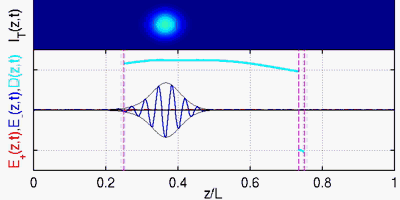Overview Freetwm
Freetwm is implemented as a toolbox to be used within Octave or Matlab. A manual is available here. It possesses the following features;
- It applies to semiconductor quantum well active medium. It uses the recently developed fast convolution kernel active medium description [3,4] that allows to model either spectrally broad gain sections or sharp, step-like saturable absorber sections around their band-edge frequencies. This approach will be further extended to other materials like e.g. Bulk semiconductor materials.
- It is fast considering the relatively high complexity of the underlying physical model. For a one millimeter long device, a simulation of half a microsecond (2 × 104 mode-locked pulses at a 40 GHz repetition rate) is done in 10 min on a standard PC with parameters typical of III-V semiconductor quantum well lasers.
- It is interfaced to Octave and Matlab. Some files are actually mex libraries callable from the Matlab command line. This allows for instance to conveniently save data in binary .mat files, perform data processing or generate illustrations in an unified framework. It is compatible with the Matlab free open source clone Octave for easy cluster deployment and easy scripting without any multiple license problems.
- It is multi-platform and works under Linux, Mac OSX and on Windows. It can run in single or double precision, sequential or parallel (Openmp), and can use or not the Intel Math Kernel Library for performance enhancements.
- The new (optional) mesh decimation method that consists in recasting the traveling wave equations into an ensemble of delayed algebraic equations [2] allows for speedups of several orders of magnitude.
- It has been extensively tested during years and confronted successfully to several experiments. The whole source code as well as all the details of the implementation and of all the approximations performed are explained and detailed, a must for anybody planning to base any work on it. The physical model for the semiconductor response, the numerical algorithm and the sparse mesh method are detailed in the manual.
- At last, it is extremely simple to use: a complex photonic structure can be described and simulated by a straightforward script of 20 lines. The manual details several examples and their accompanying scripts to help get the user started.

Movie Legend: temporal evolution of a pulsating passively mode-locked laser composed of a passive section,
an amplifier, a saturable absorber and another passive section. The forward and backward waves and the population
inversion are represented in red, dark and light blue, respectively. The population grating amplitude close to the mirror
has been exaggerated for clarity.